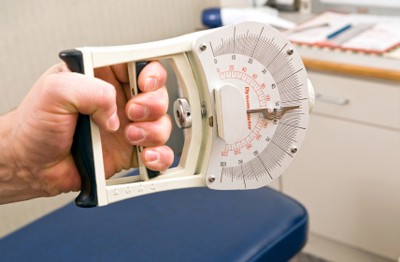
When Richard Bohannon does physical therapy with his stroke and cancer patients, the one thing he always makes sure to check is their grip strength.
While not yet widely used in the medical community, a grip strength test can be an important screening tool in assessing a person’s overall health, says Dr. Bohannon, a professor of physical therapy in the Department of Kinesiology at the Neag School of Education.
“Weakness is one of those cluster signs of frailty,” says Bohannon. “There are other things, like unintentional weight loss and a particularly slow gait. But grip strength gives you an overall sense of someone’s vitality. It is reflective of muscle mass and can be used to predict things in the future like post-operative complications and even death.”
By obtaining a reading of a person’s overall muscle mass and strength level, health care practitioners can prescribe nutritional guidelines, exercises, and other interventions in an attempt to increase strength if necessary and improve the person’s overall health and vitality.
“It’s not that I want their grip strength to be bigger or better,” says Bohannon, who last year was named a Fellow of the American Society of Neurorehabilitation. “I want them to be stronger. I want them to be fit. They need reserve, in case they experience an untoward event such as an infection.”
To measure grip strength, Bohannon uses a hand-held device called a dynamometer, which measures force. It can record forces over a wide spectrum.
Several years ago, Bohannon conducted a systematic review of peer-reviewed journal articles to assess the adequacy of using hand-grip dynamometry as a predictor of important health outcomes. The majority of the studies focused on middle-aged and older adults. The results, published in the Journal of Geriatric Physical Therapy, supported “the value of grip strength as a predictor of mortality, disability, complications, and increase length of [hospital] stay.” Even when grip strength was adjusted for potentially confounding variables, it was “a consistent predictor of important outcomes,” the study showed.
“You really can tell a little bit about people and where they stand, based on grip strength,” says Bohannon, measurement of muscle spasticity, is among the most cited in medical rehabilitation literature. “There was a study done that looked at folks’ middle age. The authors found that weakness in middle age was predictive of problems later, predictive of the onset of disability. Those who were weaker in their 40’s and 50’s were more likely to demonstrate an onset of disability in their 60’s.”
Maintaining fitness helps individuals combat infection and rebound from illness, Bohannon says.
“If you experience weakness that accompanies aging and you have a stroke or serious infection, it can definitely be a problem,” Bohannon says. “For instance, if it takes all the strength you can muster to get out of a chair now and you suddenly get a urinary tract infection, it is likely you will have more trouble getting up because you don’t have any reserve.”
Bohannon says he recently worked with a new cancer patient, and while she did standard sit-to-stand and grip strength assessments adequately, he cautioned her that she might want to do some things to increase her strength.
“I told her she was going to be undergoing chemo and maybe some other things in the near future that are going to knock her down a peg or two and there is no time like today to start doing things to increase her strength,” he says. “You need to build up a reserve so that when these things happen, you have enough strength to manage.”
Bohannon says basic exercises like moving from a sitting to standing position can help build strength in older individuals simply using their body weight and gravity. Walking up stairs or stepping up to the bottom stair and back to the floor also helps. Holding onto a counter and rising up on one’s toes is another good exercise. Of course, older individuals should consult their personal physician before starting any new exercises, and should always be careful about the possibility of a fall.
In a separate study published in Perceptual and Motor Skills last year, Bohannon looked at grip strength in 41 home-care patients with diverse diagnoses ranging from stroke and cancer to fracture and osteoarthritis. He found that the patients (as a whole) were weaker than normal for age and sex.
For patients with cancer or those recovering from stroke, reduced grip strength might be anticipated. But impaired grip strength is less predictable among other patients such as those suffering lower extremity fractures, recovering from back surgery, fall victims, pulmonary disease, and cellulitis.
In his conclusion, Bohannon said that the study, while small, was evidence that the sensitive dynamometer measurements “demonstrated a magnitude and prevalence of hand weakness not likely to have been identified” if the tool wasn’t used; and that it showed the dynamometer’s value as a standard assessment tool for patients in a home-care setting.
“I use dynamometers with almost every patient I have because I think it is important,” Bohannon says. “In most cases, I’m using it as a marker much like a doctor checks vital signs like blood pressure and heart rate. Very few therapists use dynamometers, which I think is unfortunate. Dynamometers are relatively inexpensive, portable, and easy to use.”
 Facebook
Facebook
 Twitter
Twitter
 LinkedIn
LinkedIn
